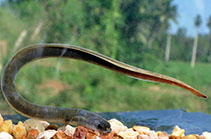| Family: |
Anguillidae (Freshwater eels) |
| Max. size: |
123 cm TL (male/unsexed); max. reported age: 20 years |
| Environment: |
demersal; freshwater; brackish; marine, catadromous |
| Distribution: |
Indo-Pacific: widespread in the tropical Indian Ocean and western Pacific. Known in Australia only from streams in the Kimberley regions of northern western Australia. Africa: widespread but relatively uncommon along east and southeast African coast and Madagascar (Ref. 7248, 52193). Mozambique; Lower Zambezi River (Ref. 39494). Most easily confused with Anguilla obscura and the surest way to distinguish them is by the count of vertebrae (Ref. 9828). |
| Diagnosis: |
Dorsal spines (total): 0-0; Dorsal soft rays (total): 240-245; Anal spines: 0-0; Anal soft rays: 200-220; Vertebrae: 105-115. Description: Dorsal fin origin above vent (Ref. 12693), much closer to anal fin origin than to gill slit (Ref. 52193). Eyes before angle of jaw (Ref. 52193). Teeth bands broad without gasps between teeth rows; teeth small, inconspicuous, multiserial, forming broad continuous bands on jaws and vomer; vomerine tooth-band extending as far back as bands of upper jaw but more pointed posteriorly (Ref. 4832, 52193). Colouration: Dorsal body colour uniform (Ref. 79840). Olive to dark bluish-brown dorsally, lighter ventrally from jaw to anus (Ref. 3971, 52193). Mature adults change to bronzy silver (Ref. 52193). |
| Biology: |
Migratory species which breeds in the ocean (Ref. 52331, 79840). Lives in fresh water areas as an adult, in estuaries and seas as young (Ref. 12693). Descends to the sea to spawn. Inhabits freshwater streams and pools, preferring marshy habitats (Ref. 41236). Found in rivers and creeks, commonly over rock bottoms and in deeper pools. Seldom occurs in large rivers (Ref. 6028). Restricted to lowland (coastal) reaches of river systems (Ref. 7248). Feeds on small fishes, crustaceans and mollusks. Reported to breed east of Madagascar; the south equatorial current probably carries the eel larvae and elvers towards the east coast of Africa where local coastal currents guide the elvers to suitable rivers which they invade and they stay there until sexually mature, when they return to their breeding grounds (Ref. 13337). Caught with various types of nets. Sometimes used in the aquarium trade (Ref. 6028). |
| IUCN Red List Status: |
Near Threatened (NT); Date assessed: 11 August 2019 (A2bcde) Ref. (130435)
|
| Threat to humans: |
harmless |
Source and more info: www.fishbase.org. For personal, classroom, and other internal use only. Not for publication.
